
French Polynesia - The Society Islands
Summer 2014

|
Fishies fishies everywhere! |

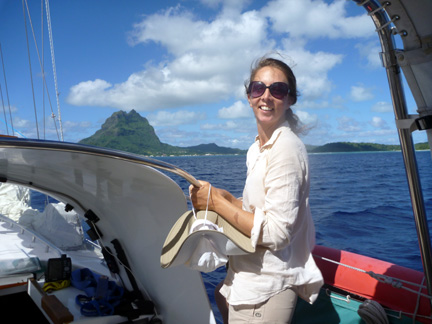
|
We were eleven days at sea from the Isles Gambier to the Leeward Societies. We actually made land at Taha’a the evening before, and gratefully slept just inside the pass, but we didn’t feel like we’d really arrived until we saw the unmistakable profile of Bora Bora’s blown-out volcano the next day. |
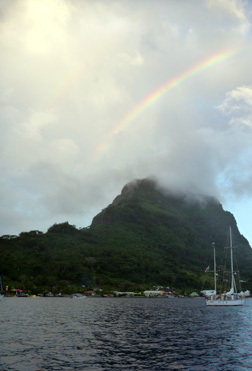
|
We rented a scooter to tour the main island at Bora Bora, since buses are rather rare. Most hotels and businesses run water taxis, which kept our boat rocking constantly during our stay. The scooter was less powerful than Paul might have hoped, but after a boat anything above five knots feels fast. We visited the famous Bloody Mary’s watering hole, where Gunter attracted attention from colorful characters while we enjoyed cold Hinanos. |
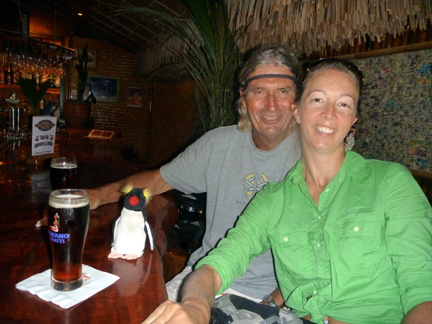
|
| Anchoring on the leeward side of these high islands makes it hard to see the weather coming (it’s raining on the laundry again!), but it’s always fun to watch the clouds eat the mountain. Somewhere up those steep cliffs is a pot of gold . . . or some very pretty flowers . . . or the mythical naked girls from the postcards. After exploring all the way around the island, we never found the Bora Bora we’d been hoping for. The pristine waters and deserted beaches have given way to over-water bungalows and jet skis. We day-sailed to Taha’a, where cruising friends say it’s less touristy. | ||
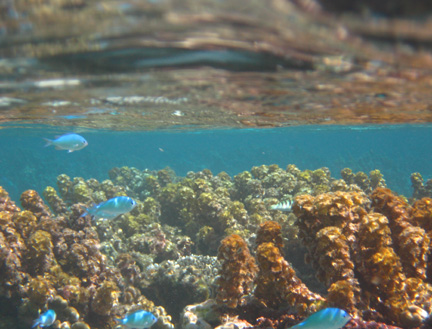
|
A fantastic snorkeling spot at Taha’a has been conserved by both the hotel and a local family living on the motu nearby. We spent a whole day hangin’ with the colorful fishies in this shallow coral labyrinth while they posed for the camera (note the parrot-fish smiling). A color-changing reef octopus was less interested in being photographed, but was very cool to see in daylight. In all the excitement Bonnie scratched her hand on a coral head, ending our swimming for a few days. We spent the time hiking to a vanilla plantation, and enjoying the very good internet at the Hibiscus moorings in Ha’amene Bay. We reliably forgot to bring the camera with us, but it was a very welcoming island. |
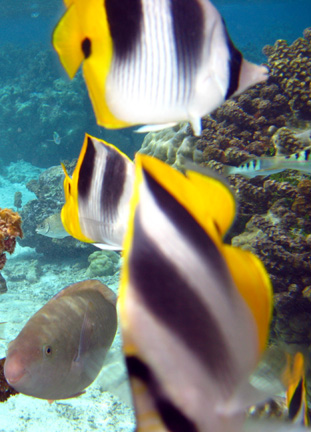
|
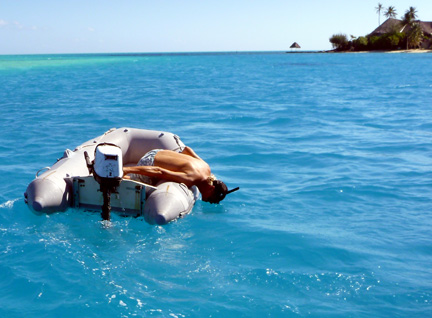
|
By the time we hopped across to Huahine, we were ready to spend lots more time in the water. Paul experimented with a new technique of high-speed snorkeling from the dinghy (he's actually checking out a mooring block). We saw our first black-tip reef shark here, though it was so scared of us we didn’t have a chance to snap a picture. We found a nice shallow anchorage on a shelf where we could swim to the outer reef, and where the rays came to inspect us. Bonnie got her first lesson on diving with the hookah before we packed up for the two-day beat to the Windward islands. |

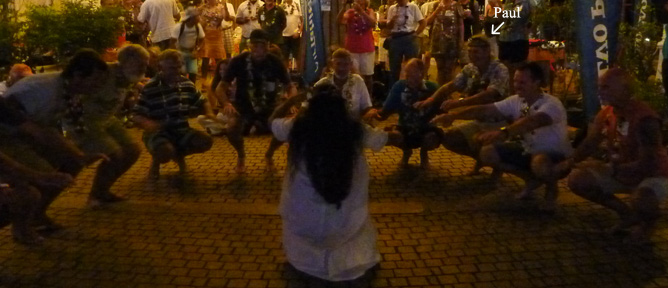
|
Our first order of business in the Windward Societies (after some boat chores) was the Pacific Puddle Jump Rendezvous. Bonnie sipped a cocktail while the captains received a blessing and learned to dance Tahitian-style (sort-of). |
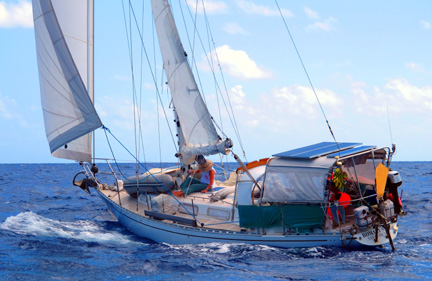
|
We held our own in the regatta from Tahiti to Moorea . . . until the wind went light and the big boats put out their spinnakers. Romany Star held her record of never quite coming in last, which is a lot to be said for a heavily-laden little cruiser. Cook's Bay rarely sees such a crowd, but the impressive rock formations kept calm watch over us all. |
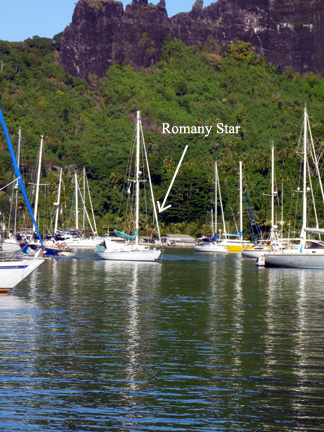
|
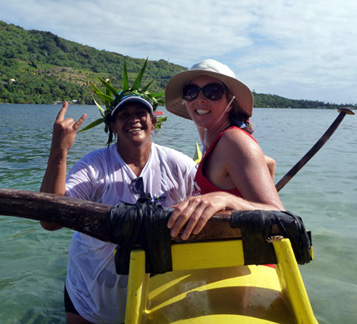
|
The Puddle Jump crew put together some very fun festivities, in which we got to learn to paddle on a six-person outrigger canoe team (va'a). Our team won the coveted prize of sitting out the later heats while our arms recovered. Several conniving canoes flipped their paddlers into the lagoon (you have to lean towards the outrigger), possibly helped by competing teams lifting their outriggers. |
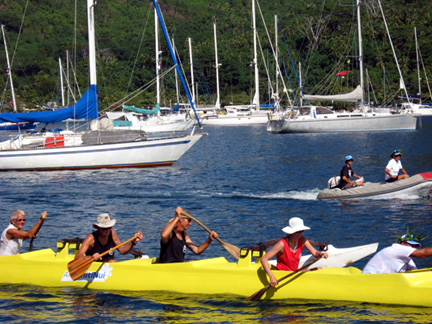
|
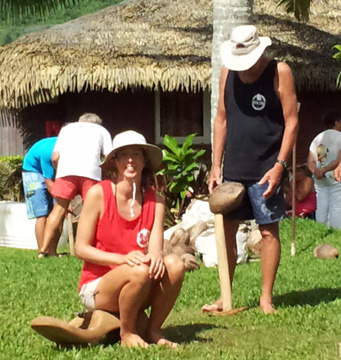
|
We competed in several local sports, including coconut husking (harder than you'd think), fruit-carrying races, and dancing (after Paul's experience at the blessing ceremony, his knees sat this one out). Bonnie even convinced a local craftsman to show her how to climb coconut trees (which she can do . . . for about three feet). Our local coaches for these events turned out to be the real athletes and coaches we would later see at the national Heiva competitions! |
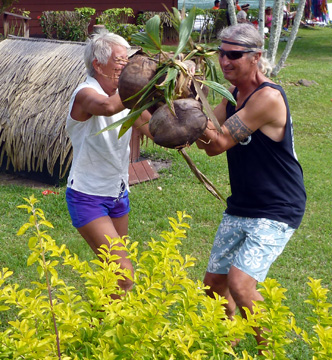
|
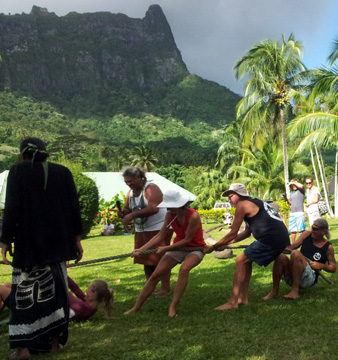
|
We don't think the tug-of-war was a traditional Polynesian sport, but it was lots of silly fun. The best part of the events was spending time with cruiser friends we've known since the other side of the Pacific, most of whom are continuing west. We'll catch up with them in a few years as we meander across the Pacific in our zig-zag fashion. |
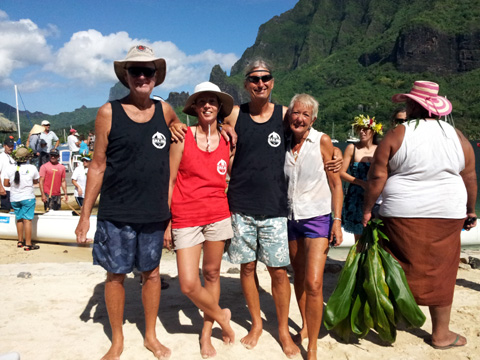
|
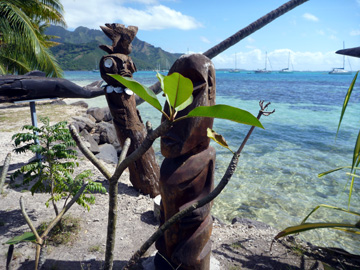
|
After the Rendezvous, we hopped around Moorea to Paul's favorite tiki-guarded anchorage on Oponohu Bay. We snorkeled and kayaked, and enjoyed the relaxing sounds of children enjoying the beach. |
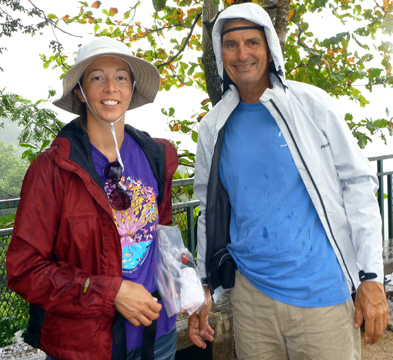
|
We took the renown hike up to the Bellvedere between Oponohu and Cook's bays, through the ranching and farming valleys. Well, we actually hitched a ride up, and walked down (like smart cruisers - it still took several hours). The view got lost in the rain of a front coming through, but Gunter stayed dry in his high-tech foulies (don't worry, stuffed penguins can't asphyxiate). There were mysterious stone maraes (holy places) scattered through the beautiful rainforest. This mape tree seemed to be weaving its own holy place with its roots, a perfect symbol of the peace of Moorea. |
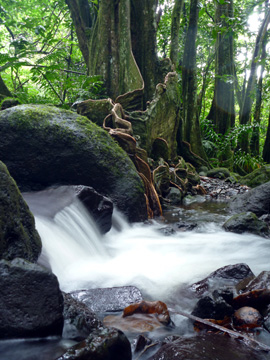
|

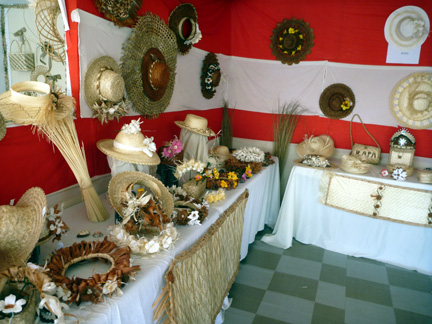
|
Back in Tahiti the national Heiva festival was in full swing. The handicrafts fair had art from every sizeable village in the country, and took us two days to enjoy thoroughly. We staked out a spot in the park to watch the traditional fruit-carrying race, which was a spectacle of strength and endurance (and well-muscled tattooed men). |
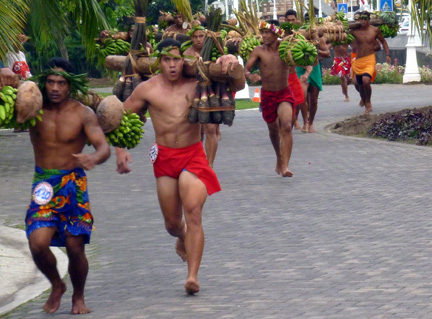
|
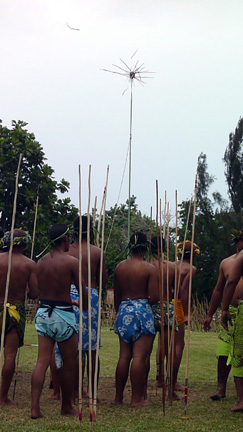
|
Bonnie and Gunter particularly enjoyed the javelin-throwing contest, in which the target in a modest coconut way up on a 70-foot pole. The javelins are thin, flexible spears that wiggle as they fly through the air, and seem very difficult to aim with power. When the whole field of athletes throws at once, the impression is of the wiggly javelins trying to fertilize the coconut. This athlete is a longtime competitor (and is featured in the 2009 pictures also), who gave a perfect display of calm concentration in his style. |
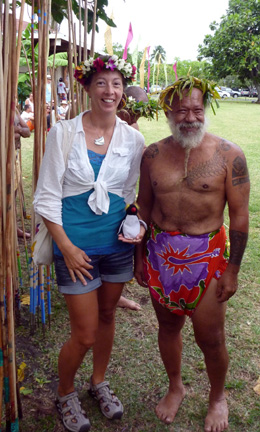
|
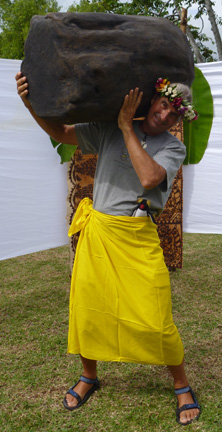
|
The stone-lifting competition is the ultimate show of strength for the Polynesians. Gunter helped Paul lift this huge and heavy block of basaltic styrofoam, just like the real athletes. |
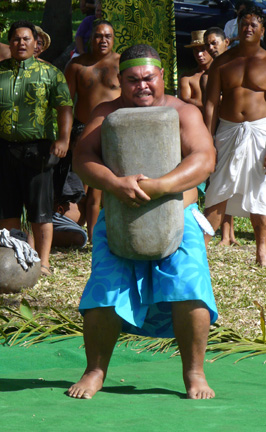
|
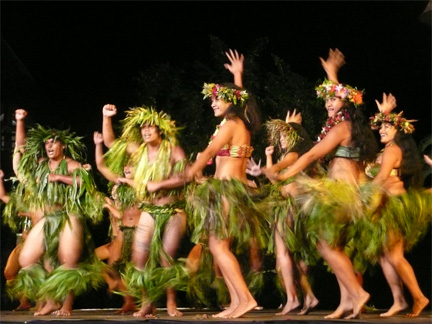
|
Dancing is the highlight of the Heiva cultural festival. Dance troupes come from all over the country to compete in several different categories, and we were lucky enough to see several of the winning groups. The traditional singing and drumming is as stunningly beautiful as the athletic dancing. Though the impressively vigorous movements sometimes shake the traditional vegetal costumes loose, the dancers do wear minimal modern coverings underneath (one can see the allure of vegetal lingerie) |
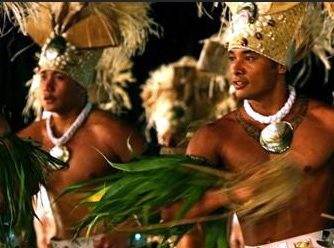
|

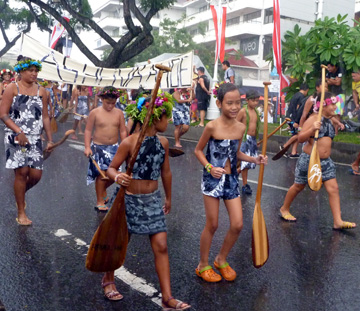
|
Autonomy Day is the French Polynesian equivalent of an independence day (as close as they've gotten so far), and cause for a parade in which every village in the Windwards is represented. A big squall came over the island and drenched everyone right in the middle of the parade, but most of these tropical-dwellers took it in stride. The va'a (canoe paddling) clubs seemed most at home in the water, and the dance schools seemed just as alluring when wet. |
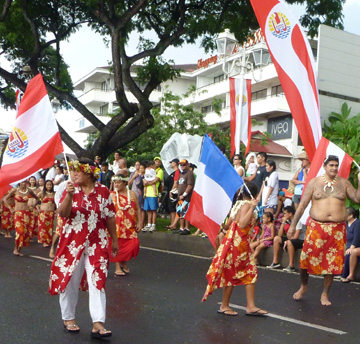
|
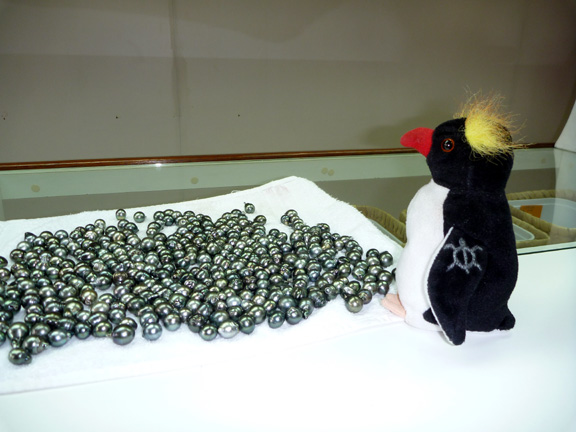
|
We went pearl-crazy for a few days, setting the pearls we bought in the Gambier and considering a few more. Gunter was interested in a pearl earring, but he turns out not to have ears. |
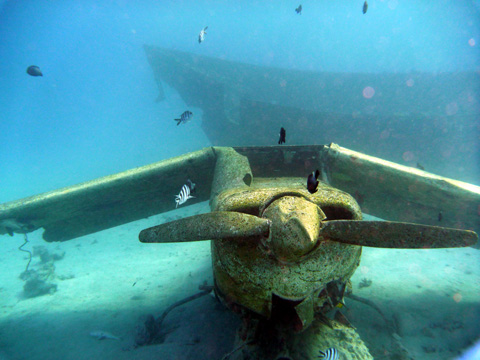
|
We hadn't anticipated snorkeling much at Tahiti, but there's a cool spot with a sunken plane wreck and a boat (both sunken here intentionally after everyone got off them alive). A friend flew in a fancy new snorkel for Bonnie, which was much more comfortable when she wanted to spend lots of time imitating the rays (they weren't amused). |
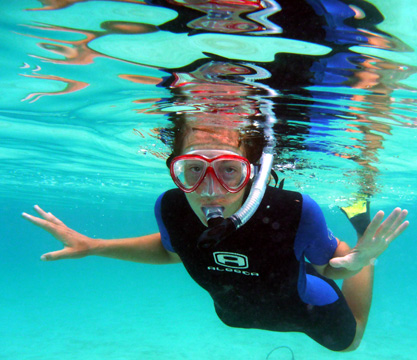
|
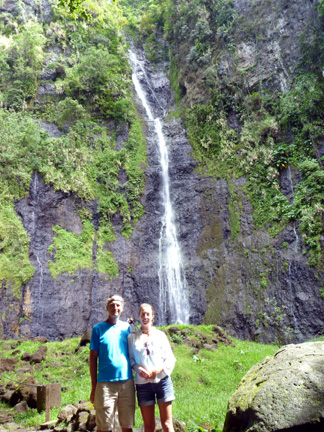
|
Tahiti is famous for her beautiful high waterfalls shooting down sheer cliffs into lush valleys, and we found a few of them. The fresh water is shockingly cold compared to the warm lagoons, but refreshing after a hot hike. Gunter was concerned about centipedes, but the only one we saw was crossing a road and seemed uninterested in a penguin. |
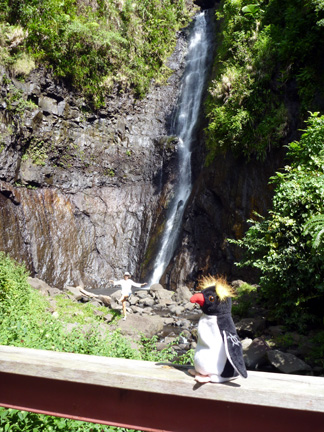
|
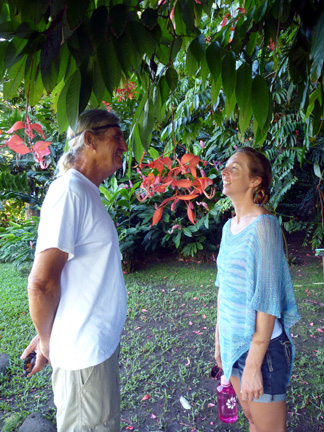
|
We visited the lovely Botanical Gardens and Water Gardens on Tahiti's south side, and even anchored off the Botanical Gardens for a couple days before leaving Tahiti entirely. These gardens are used to cultivate and teach about native plants, and also to see how non-natives will interact with the ecosystem (before they're set loose to be invasive). The mape forests surrounded by dark swampy water are clearly mysterious and magical forests, where one might meet any number of fairies or gnomes. |
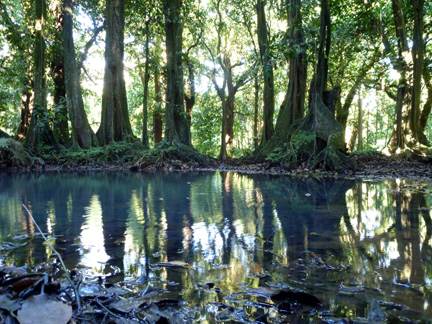
|
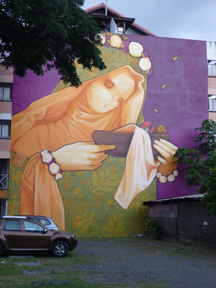
|
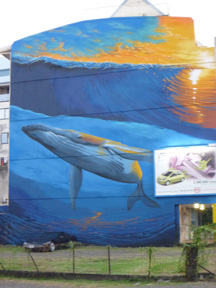
|
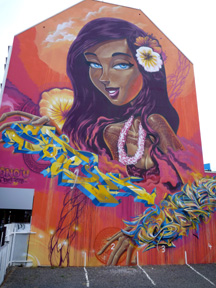
|
| Downtown Papeete hosted a street-art competition earlier this year, and these murals were some of Paul's favorites. Just another example of this beauty-loving culture: flowers behind ears and art around every corner. | ||
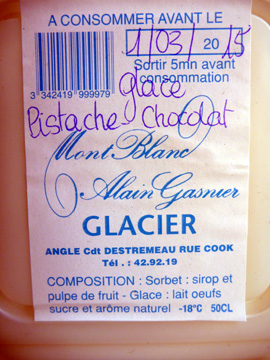
|
One of our favorite things about Papeete was the very good local creamery. On most islands "ice cream" is highly processed light sugary fluff with no actual cream in it. So we savored every opportunity to get some real ice cream while we could (and our waistlines started to show it). The last Papeete ice cream was quite a ceremony, as we prepared to push off for the Tuamotu atolls. |
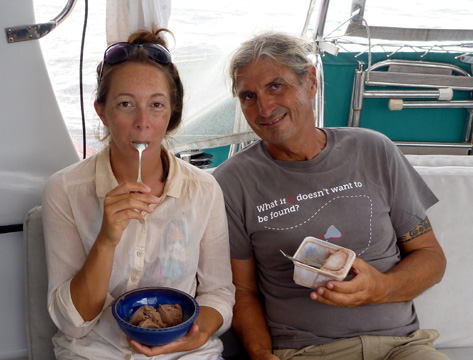
|